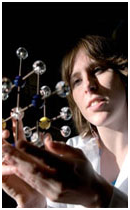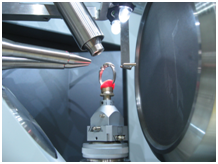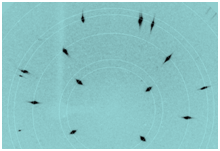
 Not content with showing off the eye-catching brilliance of her new diamond engagement ring, final year Inorganic Chemistry student Rowena Scott wanted to reveal the beautiful symmetry of its atomic structure. She recorded an X-ray diffraction pattern from the diamond using one of the Chemistry Department’s new state of the art, SuperNova dual source X‑ray diffractometers.
Not content with showing off the eye-catching brilliance of her new diamond engagement ring, final year Inorganic Chemistry student Rowena Scott wanted to reveal the beautiful symmetry of its atomic structure. She recorded an X-ray diffraction pattern from the diamond using one of the Chemistry Department’s new state of the art, SuperNova dual source X‑ray diffractometers.
Rowena’s current research project with Dr Simon Clarke involves the synthesis of iron chalcogenide superconductors. The structures of these materials are then determined using single crystal X-ray diffraction techniques.
Chemical Crystallography Service manager, Dr Amber Thompson said “We see a wide range of materials of varying crystallinity from many research groups in the Department of Chemistry, usually grown at the bottom of glass schlenks or flasks; it’s not often that such a lovely crystal turns up mounted in a band of gold”.
 The diffracted X-rays were measured while rotating the diamond in an X-ray beam. The resulting diffraction pattern shows the position and intensity of the beams diffracted by the organised structure of carbon atoms in the crystal. The white rings overlaid on the image indicate the angles at which diamond peaks are expected to occur, which agree with the collected data.
The diffracted X-rays were measured while rotating the diamond in an X-ray beam. The resulting diffraction pattern shows the position and intensity of the beams diffracted by the organised structure of carbon atoms in the crystal. The white rings overlaid on the image indicate the angles at which diamond peaks are expected to occur, which agree with the collected data.
Diamond diffracts X-rays so efficiently that the X-ray generator had to be run at 10% of its usual power in order to avoid overloading the X-ray detector.